 Kinetta, 2005. Something of a hybrid between Tsai Ming-liang’s eccentric, temp morts snapshots of human idiosyncrasy crossed with the glacially paced visual abstraction of Sharunas Bartas by way of Philippe Grandrieux’s murky, destabilized, and defocused gaze (in particular, Sombre), Yorgos Lanthimos creates a languid, elliptically fractured, and maddeningly opaque, yet strangely transfixing and, on rare occasion, even sublime meditation on ennui, desolation, and ritual in Kinetta. Ostensibly structured as a metafilm (a premise that echoes Tsai’s The River and The Wayward Cloud), the film follows the curious activities of a threadbare amateur film crew as they set out to re-enact episodes from recent murder cases for unspecified (and perhaps indeterminate) motives at a near empty, off-season seaside hotel: an emotionally troubled chambermaid who seems to be more consumed with deciphering the lives of the hotel guests by lingering in their vacated rooms and going through their toiletries and personal effects than in completing her tasks efficiently; a printing and photography reproduction shop worker who aspires to become a filmmaker even as he seems oblivious to practical notions of customer requirements and working deadlines; a plainclothes police officer who devotes more of his time transcribing the details of the murders for their re-enactment project than in the actual solving of the cases. Chronicling the film crew’s oppressive silence, introversion, and awkward interaction, Lanthimos captures the unarticulated despair behind their morbid obsession to create an incisive (if frustrating) exposition on loneliness, longing, and the human search for transitory connection.
Kinetta, 2005. Something of a hybrid between Tsai Ming-liang’s eccentric, temp morts snapshots of human idiosyncrasy crossed with the glacially paced visual abstraction of Sharunas Bartas by way of Philippe Grandrieux’s murky, destabilized, and defocused gaze (in particular, Sombre), Yorgos Lanthimos creates a languid, elliptically fractured, and maddeningly opaque, yet strangely transfixing and, on rare occasion, even sublime meditation on ennui, desolation, and ritual in Kinetta. Ostensibly structured as a metafilm (a premise that echoes Tsai’s The River and The Wayward Cloud), the film follows the curious activities of a threadbare amateur film crew as they set out to re-enact episodes from recent murder cases for unspecified (and perhaps indeterminate) motives at a near empty, off-season seaside hotel: an emotionally troubled chambermaid who seems to be more consumed with deciphering the lives of the hotel guests by lingering in their vacated rooms and going through their toiletries and personal effects than in completing her tasks efficiently; a printing and photography reproduction shop worker who aspires to become a filmmaker even as he seems oblivious to practical notions of customer requirements and working deadlines; a plainclothes police officer who devotes more of his time transcribing the details of the murders for their re-enactment project than in the actual solving of the cases. Chronicling the film crew’s oppressive silence, introversion, and awkward interaction, Lanthimos captures the unarticulated despair behind their morbid obsession to create an incisive (if frustrating) exposition on loneliness, longing, and the human search for transitory connection.
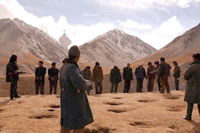 Kekexili: Mountain Patrol, 2004. In an early episode in the film, retired army officer turned volunteer poacher tracking commander Ritai (Duobuji) explains to a Beijing reporter Ga Yu (Zhang Lei) that according to custom, a Tibetan native would point his knife inward when cutting his meal at the dinner table. It is a seemingly anecdotal comment on cultural particularity that also serves as a broader metaphor for the environmental and social climate of the Kekexili during the mid 1990s, a stretch of uninhabited land dubbed the last virgin wilderness in China, as natives increasingly redirected their meager livelihood towards the dangerous and ecologically destructive, yet more lucrative trade of poaching Tibetan antelopes to meet international demand for their woolen pelts. With the antelope population quickly plummeting from a million to nearly 10, 000 within the span of a few short years, and unable to enlist the aid of the government into declaring Kekexili a wildlife refuge (and therefore, deploying troops to secure the area) in order to protect the endangered animals, Ritai has assembled his own army of volunteers to patrol the mountain region in an attempt to intercede the trafficking of pelts, often leading to violent – and sometimes fatal – skirmishes with the ruthless, well-armed poachers. Embarking on long expeditions away from family, friends, and colleagues, each parting is tainted with the impassioned, bittersweet realization of tragic inevitability. Based on the Ga Yu’s real-life chronicle of the volunteer militia’s final expedition to track down a band of poachers responsible for the murder (and publicly symbolic humiliation) of a colleague, the film is an understated, yet tightly constructed and compelling portrait of moral imperative, sacrifice, and everyday heroism. Recalling the austerity and geographic isolation of Tian Zhuangzhuang’s The Horse Thief, Lu Chuan similarly evokes a metaphoric image of alienation and spiritual desolation through panoramic shots of the majestic and unforgiving landscape (most notably, in the recurring shots of antelope carcasses and laid out animal pelts that reinforce the criticality of an unfettered mass extinction). It is in these curious images of despiritualized landscape that the film can be seen, not only through the filter of ecological responsibility, but also as a cautionary tale for the extinction of cultural identity within the unbridled frontier of globalism.
Kekexili: Mountain Patrol, 2004. In an early episode in the film, retired army officer turned volunteer poacher tracking commander Ritai (Duobuji) explains to a Beijing reporter Ga Yu (Zhang Lei) that according to custom, a Tibetan native would point his knife inward when cutting his meal at the dinner table. It is a seemingly anecdotal comment on cultural particularity that also serves as a broader metaphor for the environmental and social climate of the Kekexili during the mid 1990s, a stretch of uninhabited land dubbed the last virgin wilderness in China, as natives increasingly redirected their meager livelihood towards the dangerous and ecologically destructive, yet more lucrative trade of poaching Tibetan antelopes to meet international demand for their woolen pelts. With the antelope population quickly plummeting from a million to nearly 10, 000 within the span of a few short years, and unable to enlist the aid of the government into declaring Kekexili a wildlife refuge (and therefore, deploying troops to secure the area) in order to protect the endangered animals, Ritai has assembled his own army of volunteers to patrol the mountain region in an attempt to intercede the trafficking of pelts, often leading to violent – and sometimes fatal – skirmishes with the ruthless, well-armed poachers. Embarking on long expeditions away from family, friends, and colleagues, each parting is tainted with the impassioned, bittersweet realization of tragic inevitability. Based on the Ga Yu’s real-life chronicle of the volunteer militia’s final expedition to track down a band of poachers responsible for the murder (and publicly symbolic humiliation) of a colleague, the film is an understated, yet tightly constructed and compelling portrait of moral imperative, sacrifice, and everyday heroism. Recalling the austerity and geographic isolation of Tian Zhuangzhuang’s The Horse Thief, Lu Chuan similarly evokes a metaphoric image of alienation and spiritual desolation through panoramic shots of the majestic and unforgiving landscape (most notably, in the recurring shots of antelope carcasses and laid out animal pelts that reinforce the criticality of an unfettered mass extinction). It is in these curious images of despiritualized landscape that the film can be seen, not only through the filter of ecological responsibility, but also as a cautionary tale for the extinction of cultural identity within the unbridled frontier of globalism.
 Eli, Eli, Lema Sabachthani?, 2005. Shinji Aoyama returns to the desolate geographical and spiritual landscapes of Eureka to create a thoughtful and idiosyncratic – if patently offbeat and unclassifiable – concoction of doomsday angst, picaresque humor, synthesized cacophony, natural communion, and even redemption in Eli, Eli, Lema Sabachthani?. The film’s allusive title, taken from the Aramaic transcription of Jesus’ ninth hour utterance upon the cross (“My God, my God, why hast thou forsaken me?”), provides an insightful framework into the isolated lives of a rural hamlet’s increasingly dwindling population after a flu-like, suicide-inducing virus causes a global epidemic called Lemming’s Disease (presumably named after the popular misconception that lemming herds commit mass suicide by jumping off cliffs as a means of self-regulated population control). The film opens to a curious image in the not-so-distant future of the year 2015 as Mizui (Tadanobu Asano) and Asuhara (Masaya Nakahara) – donned in filtering face masks, goggles, and white coveralls and carrying sound recording equipment – seemingly emerge from the sea and make their way towards the shore where a deserted tent has been staked. Showing little reaction to the sight of dead bodies inside the tent, they instead turn their attention to the recording of the ambient sounds entombed with the occupants of the campsite. It is a wordless ritual that has come to define their daily life since retreating into the countryside on self-imposed exile after abandoning their former careers as world-renowned experimental musicians. However, when a scientist presents a controversial theory that the cure for the malady may lie in a patient’s live exposure to the eccentric duo’s music, their familiar ritual is disrupted by the unexpected appearance of a wealthy industrialist named Miyagi (Yasutaka Tsutsui) who, with the aid of a private detective (Masahiro Toda), has tracked down the reluctant saviors in order to plead for salvation of his afflicted granddaughter, Hana (Aoi Miyazaki), a dubious “treatment” that the musicians believe will actually trigger the suicidal impulse. Aoyama eschews conventional images of the apocalypse and instead presents a metaphoric image of antiseptic detachment and profound disconnection: apocalypse as the figurative end of humanity, a world without true human contact. It is this cautionary tale of humanity in the face of despair and instilled determination to survive that ultimately reconciles the film’s seemingly dissociated, final image of snowfall – as Mizui’s messianic experimental performance becomes an anthem for willful survival, so too does the snow represent a glimpse of silent grace in the midst of overwhelming darkness – a rage against the dying of the light.
Eli, Eli, Lema Sabachthani?, 2005. Shinji Aoyama returns to the desolate geographical and spiritual landscapes of Eureka to create a thoughtful and idiosyncratic – if patently offbeat and unclassifiable – concoction of doomsday angst, picaresque humor, synthesized cacophony, natural communion, and even redemption in Eli, Eli, Lema Sabachthani?. The film’s allusive title, taken from the Aramaic transcription of Jesus’ ninth hour utterance upon the cross (“My God, my God, why hast thou forsaken me?”), provides an insightful framework into the isolated lives of a rural hamlet’s increasingly dwindling population after a flu-like, suicide-inducing virus causes a global epidemic called Lemming’s Disease (presumably named after the popular misconception that lemming herds commit mass suicide by jumping off cliffs as a means of self-regulated population control). The film opens to a curious image in the not-so-distant future of the year 2015 as Mizui (Tadanobu Asano) and Asuhara (Masaya Nakahara) – donned in filtering face masks, goggles, and white coveralls and carrying sound recording equipment – seemingly emerge from the sea and make their way towards the shore where a deserted tent has been staked. Showing little reaction to the sight of dead bodies inside the tent, they instead turn their attention to the recording of the ambient sounds entombed with the occupants of the campsite. It is a wordless ritual that has come to define their daily life since retreating into the countryside on self-imposed exile after abandoning their former careers as world-renowned experimental musicians. However, when a scientist presents a controversial theory that the cure for the malady may lie in a patient’s live exposure to the eccentric duo’s music, their familiar ritual is disrupted by the unexpected appearance of a wealthy industrialist named Miyagi (Yasutaka Tsutsui) who, with the aid of a private detective (Masahiro Toda), has tracked down the reluctant saviors in order to plead for salvation of his afflicted granddaughter, Hana (Aoi Miyazaki), a dubious “treatment” that the musicians believe will actually trigger the suicidal impulse. Aoyama eschews conventional images of the apocalypse and instead presents a metaphoric image of antiseptic detachment and profound disconnection: apocalypse as the figurative end of humanity, a world without true human contact. It is this cautionary tale of humanity in the face of despair and instilled determination to survive that ultimately reconciles the film’s seemingly dissociated, final image of snowfall – as Mizui’s messianic experimental performance becomes an anthem for willful survival, so too does the snow represent a glimpse of silent grace in the midst of overwhelming darkness – a rage against the dying of the light.
Isolation, 2005. For his debut feature, Isolation, filmmaker Billy O’Brien channels the spirit of Ridley Scott’s Alien and David Cronenberg-styled organic metamorphosis to craft an old-fashioned, by-the-book science fiction thriller. On an isolated, rundown farm on the Irish countryside, a farmer named Dan (John Lynch) agrees to participate on a research project designed to increase bovine fertility and accelerate beef production on the recommendation of the town veterinarian, long-time friend and former lover, Orla (Essie Davis). But soon, despite extensive monitoring that seem to indicate a successful graft, the two begin to sense that the experiment has not gone completely according to plan, a nagging suspicion that is further reinforced when during a routine checkup, Orla is seemingly bitten by the unborn calf. Unable to contact Orla on the evening of the impending birth and unable to manage the task single-handedly, John summons a pair of runaway lovers squatting on the farm for help, a fateful connection that would unwittingly bind them to the mutated creature and the experimental farm. Although O’Brien demonstrates a keen eye for sustaining tension through shot composition and landscape to create a competent and atmospheric horror film, the film inevitably suffers from a derivative plot that lends itself to a certain degree of predictability and formulaic resolution.
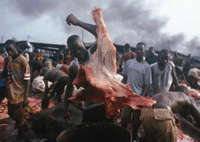 Workingman’s Death, 2005. Michael Glawogger’s pulsing, ambitiously conceived global treatise on the drudgery, and often dehumanizing, rituals of manual labor at the beginning of 21st century – over a century after the birth of the Industrial Revolution – appropriately begins in the town of Donbass in the Ukraine, the coal mining town where, in 1935, Aleksei Grigorievich Stakhanov became the archetypal model of socialist worker efficiency and productivity that gave rise to the Stakhanovite movement throughout the Soviet bloc countries. With the mines now depleted or abandoned after the collapse of the Soviet Union, coal mining remains the primary source of income for many local residents. Working in unsafe conditions in unsecured, illegal mines, the miners articulate what would prove to be recurring sentiments in all the segments: a thankfulness for their ability to earn a living and survive under the direst of circumstances, a humble appreciation for the moments of grace that they have experienced, a determination to do honest work and not fall into the lure of easy money from criminal activity. At each instance, the previous segment serves as a prefiguration of the next installment through linking images – the physical act of mining is repeated in the shot of Indonesian workers chiseling crystallized sulfur from the side of a volcano and carrying them into supple, rickety baskets across the mountainous region and into the weigh station at foot of the hills (or fashioning free-formed sculptures for passing tourists); a sacrificial sheep that is slaughtered at the beginning of the sulfur mine sequence (in a superstitious ritual to pray for the safety of the laborers) is repeated in the open market square in a Nigerian port town where people earn their daily wages from the mass slaughter, dressing, butchering, and roasting of animals; the image of docked ships in the port town is connected to the image of derelict cargo ships lining the shores of a Pakistan salvage shipyard where migrant workers dismantle the ships for scrap metal; the neon glow of the oxy-acetylene cutting torches is mirrored in the shot of steelworkers forging and welding structural construction elements in a Chinese steel plant – to create a provocative and indelible exposition on the illusion of industrial progress and advanced technology that ultimately define the myth of modern civilization.
Workingman’s Death, 2005. Michael Glawogger’s pulsing, ambitiously conceived global treatise on the drudgery, and often dehumanizing, rituals of manual labor at the beginning of 21st century – over a century after the birth of the Industrial Revolution – appropriately begins in the town of Donbass in the Ukraine, the coal mining town where, in 1935, Aleksei Grigorievich Stakhanov became the archetypal model of socialist worker efficiency and productivity that gave rise to the Stakhanovite movement throughout the Soviet bloc countries. With the mines now depleted or abandoned after the collapse of the Soviet Union, coal mining remains the primary source of income for many local residents. Working in unsafe conditions in unsecured, illegal mines, the miners articulate what would prove to be recurring sentiments in all the segments: a thankfulness for their ability to earn a living and survive under the direst of circumstances, a humble appreciation for the moments of grace that they have experienced, a determination to do honest work and not fall into the lure of easy money from criminal activity. At each instance, the previous segment serves as a prefiguration of the next installment through linking images – the physical act of mining is repeated in the shot of Indonesian workers chiseling crystallized sulfur from the side of a volcano and carrying them into supple, rickety baskets across the mountainous region and into the weigh station at foot of the hills (or fashioning free-formed sculptures for passing tourists); a sacrificial sheep that is slaughtered at the beginning of the sulfur mine sequence (in a superstitious ritual to pray for the safety of the laborers) is repeated in the open market square in a Nigerian port town where people earn their daily wages from the mass slaughter, dressing, butchering, and roasting of animals; the image of docked ships in the port town is connected to the image of derelict cargo ships lining the shores of a Pakistan salvage shipyard where migrant workers dismantle the ships for scrap metal; the neon glow of the oxy-acetylene cutting torches is mirrored in the shot of steelworkers forging and welding structural construction elements in a Chinese steel plant – to create a provocative and indelible exposition on the illusion of industrial progress and advanced technology that ultimately define the myth of modern civilization.
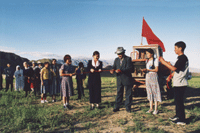 Saratan, 2005. Inviting favorable comparison to Serik Aprimov’s Glastnost-era muted comedy The Last Stop (a film that ushered the Kazakh new wave), Kyrgyzstan filmmaker Ernest Abdyshaparov spins his own charming, infectious, and delightful pastoral tale on the doldrums of rural life in post Soviet-era central Asian republics in Saratan. Introducing an eclectic cast of characters – a town mayor who has perfected the art of time-wasting activities to keep up the inflated appearance of official importance (a marginal and largely titular bureaucratic position so completely dissociated from the affairs of the national government that, as his wife points out, he doesn’t even attract bribery attempts), a once-irresponsible young man turned resident local mullah with a penchant for oversleeping through the prescribed hour for morning prayers, a lothario police officer who seems to make as many visits to wives left behind by husbands going off to work than to patrolling and investigating crime sites, a Jehovah’s witness who has come upon the rural hamlet in search of potential converts, a reactionary who continues to try to instigate the inert population into social revolution and a return to the glory days of heavy-handed Soviet socialism, a little girl who keeps a watchful eye on her unemployed, hard-drinking father, and even a local village idiot who envisions himself as a traffic officer for the town’s busiest intersection: the service window of the grocery stand – the town is soon set abuzz by the latest mystery of a sheep thief operating in the dead of night and the news that the richest man in town has purchased a stock of diesel fuel for speculative investment. Ending on an affirming note of survival, community, and humble hope, Saratan strikes the right balance of whimsical, self-effacing humor and incisive human comedy.
Saratan, 2005. Inviting favorable comparison to Serik Aprimov’s Glastnost-era muted comedy The Last Stop (a film that ushered the Kazakh new wave), Kyrgyzstan filmmaker Ernest Abdyshaparov spins his own charming, infectious, and delightful pastoral tale on the doldrums of rural life in post Soviet-era central Asian republics in Saratan. Introducing an eclectic cast of characters – a town mayor who has perfected the art of time-wasting activities to keep up the inflated appearance of official importance (a marginal and largely titular bureaucratic position so completely dissociated from the affairs of the national government that, as his wife points out, he doesn’t even attract bribery attempts), a once-irresponsible young man turned resident local mullah with a penchant for oversleeping through the prescribed hour for morning prayers, a lothario police officer who seems to make as many visits to wives left behind by husbands going off to work than to patrolling and investigating crime sites, a Jehovah’s witness who has come upon the rural hamlet in search of potential converts, a reactionary who continues to try to instigate the inert population into social revolution and a return to the glory days of heavy-handed Soviet socialism, a little girl who keeps a watchful eye on her unemployed, hard-drinking father, and even a local village idiot who envisions himself as a traffic officer for the town’s busiest intersection: the service window of the grocery stand – the town is soon set abuzz by the latest mystery of a sheep thief operating in the dead of night and the news that the richest man in town has purchased a stock of diesel fuel for speculative investment. Ending on an affirming note of survival, community, and humble hope, Saratan strikes the right balance of whimsical, self-effacing humor and incisive human comedy.
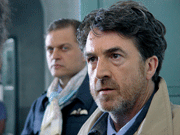 Days in the Country, 2004. Continuing his preoccupation with the interpenetration of time and memory, fiction and reality of Time Regained (that would be further explored in the subsequent film The Lost Domain), Days in the Country marks Raoul Ruiz’s first Chilean feature film in thirty years. Perhaps inspired by the curious radio news broadcast of his own death, an aging gentleman, Don Federico (Mario Montilles) decides to retire to his country estate in order to put down on paper an unfinished novel that has consumed his thoughts for decades – the incompletion of which has been a long-running joke and recurring topic of conversation by the regulars at his habitual café. But returning to the solitude of the country proves to be an immersive, if not surreal, experience as characters from his unrealized novel begin to act out their roles in real life, and memories from his past – his devoted maid Paulita (Bélgica Castro), family friend and town physician Dr. Chandian (Francisco Reyes), and even an old neighbor who died from an accidental dog mauling – begin to resurface in the present (made all the more tortuous and fantastic by their physical resemblance to the regular cast of characters at the café). Ruiz’s whimsical conflation of reality and imagination defies easy categorization or tidy resolution, but nevertheless, provides a witty, incisive, and ingeniously crafted meditation on mortality, regret, memory, and the iterative process of artistic creation.
Days in the Country, 2004. Continuing his preoccupation with the interpenetration of time and memory, fiction and reality of Time Regained (that would be further explored in the subsequent film The Lost Domain), Days in the Country marks Raoul Ruiz’s first Chilean feature film in thirty years. Perhaps inspired by the curious radio news broadcast of his own death, an aging gentleman, Don Federico (Mario Montilles) decides to retire to his country estate in order to put down on paper an unfinished novel that has consumed his thoughts for decades – the incompletion of which has been a long-running joke and recurring topic of conversation by the regulars at his habitual café. But returning to the solitude of the country proves to be an immersive, if not surreal, experience as characters from his unrealized novel begin to act out their roles in real life, and memories from his past – his devoted maid Paulita (Bélgica Castro), family friend and town physician Dr. Chandian (Francisco Reyes), and even an old neighbor who died from an accidental dog mauling – begin to resurface in the present (made all the more tortuous and fantastic by their physical resemblance to the regular cast of characters at the café). Ruiz’s whimsical conflation of reality and imagination defies easy categorization or tidy resolution, but nevertheless, provides a witty, incisive, and ingeniously crafted meditation on mortality, regret, memory, and the iterative process of artistic creation.
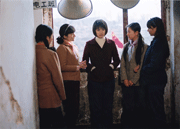 Shanghai Dreams, 2005. During the Cultural Revolution, Qinghong’s parents took up Mao Zedong’s call for a Third Line of Defense by relocating from Shanghai to work at factories on a rural outpost in the Guizhou Province. Years later, their ever-dimming hope of returning home has been re-channeled into the raising of their daughter, believing that their best prospects for their children’s re-integration into the city lies in Qinghong (Gao Yuanyuan) obtaining a college education and maintaining their social separation from the provincial locals. But Qinghong’s sentiments for her adoptive hometown is less entrenched, having become accustomed to the quiet rhythms of the bucolic town (a familiarity of ritual reflected in the recurring images of her morning exercises at school and her clandestine meetings with a local young man who works as a mill apprentice). Driven to near obsession to spare his children from repeating the disappointments and failures of his own frustrated life in exile and encouraged by recent political developments that seemingly point towards an opportunity for relocated workers to finally return home to Shanghai, Qinghong’s father becomes increasingly intrusive in his daughter’s budding romance and drives a wedge between the two in preparation for what he believes will be their impending departure, unwittingly setting the stage for the reluctant young couple’s conflicted farewell. Using predominantly medium shots and incorporating recurring long shot landscape images to create a pervasive sense of distance and estrangement, Wang Xiaoshuai evokes the resigned nostalgia of uprooting and perpetual exile of Hou Hsiao-hsien’s The Time to Live and the Time to Die and Jia Zhang-ke’s attention for quotidian details that humorously encapsulate provincial youth culture (most notably, Platform) in Shanghai Dreams to create an understated, yet compelling and incisive tale of displacement, consuming obsession, and failed idealism.
Shanghai Dreams, 2005. During the Cultural Revolution, Qinghong’s parents took up Mao Zedong’s call for a Third Line of Defense by relocating from Shanghai to work at factories on a rural outpost in the Guizhou Province. Years later, their ever-dimming hope of returning home has been re-channeled into the raising of their daughter, believing that their best prospects for their children’s re-integration into the city lies in Qinghong (Gao Yuanyuan) obtaining a college education and maintaining their social separation from the provincial locals. But Qinghong’s sentiments for her adoptive hometown is less entrenched, having become accustomed to the quiet rhythms of the bucolic town (a familiarity of ritual reflected in the recurring images of her morning exercises at school and her clandestine meetings with a local young man who works as a mill apprentice). Driven to near obsession to spare his children from repeating the disappointments and failures of his own frustrated life in exile and encouraged by recent political developments that seemingly point towards an opportunity for relocated workers to finally return home to Shanghai, Qinghong’s father becomes increasingly intrusive in his daughter’s budding romance and drives a wedge between the two in preparation for what he believes will be their impending departure, unwittingly setting the stage for the reluctant young couple’s conflicted farewell. Using predominantly medium shots and incorporating recurring long shot landscape images to create a pervasive sense of distance and estrangement, Wang Xiaoshuai evokes the resigned nostalgia of uprooting and perpetual exile of Hou Hsiao-hsien’s The Time to Live and the Time to Die and Jia Zhang-ke’s attention for quotidian details that humorously encapsulate provincial youth culture (most notably, Platform) in Shanghai Dreams to create an understated, yet compelling and incisive tale of displacement, consuming obsession, and failed idealism.
 The Lost Domain, 2004. Recalling the whimsical, organic transections between past and present, dream and reality, literature and real-life of Raoul Ruiz’s earlier films Memory of Appearances and Time Regained, The Lost Domain is a more somber and pensive, yet still vibrant, impassioned, and intelligently constructed exposition on the process of maturation, the demystification of a childhood hero, and the inevitable loss of innocent wonder and fanciful imagination. As the film begins, a unseen narrator recounts a tale from his Chilean hometown of a ghost ship once moored near the shore whose presence only became an unprovable myth – the stuff of legends – after the villagers ceased to speak of its strange presence on the horizon and recount its fantastic tale. This introductory notion of tale-telling as the figurative lifeblood to existence and identity serves as the Pirandellian framework for Ruiz’s tale of a boy from a rural town who is befriended by an abstracted French aviator and chronic storyteller, Antoine (François Cluzet) (and whose life curiously mirrors the wandering hero from Alain-Fournier’s classic novel, Le Grand Meaulnes) after he makes an emergency landing in their community during a topographic surveying expedition. Weaving through past and present as the boy, Max becomes a kind of de facto tale-teller at various stages in life: first, as a young flight instructor (Grégoire Colin) training Antoine, now an obsolete pilot unable to navigate the controls of a modern airplane during World War II, then as a middle-aged country gentleman who harbors a young couple after breaking curfew to meet with him and find information on his grandfather, Antoine, who was declared missing in action after conducting a night-time reconnaissance operation during the war. At each juncture, the encounter becomes an understated elegy of time passed – a skeptical young man refusing to acknowledge his youthful gullibility, a middle-aged man who regrets his imposed estrangement from his boyhood hero during their last encounter, an old man acutely aware of his mortality and solitude.
The Lost Domain, 2004. Recalling the whimsical, organic transections between past and present, dream and reality, literature and real-life of Raoul Ruiz’s earlier films Memory of Appearances and Time Regained, The Lost Domain is a more somber and pensive, yet still vibrant, impassioned, and intelligently constructed exposition on the process of maturation, the demystification of a childhood hero, and the inevitable loss of innocent wonder and fanciful imagination. As the film begins, a unseen narrator recounts a tale from his Chilean hometown of a ghost ship once moored near the shore whose presence only became an unprovable myth – the stuff of legends – after the villagers ceased to speak of its strange presence on the horizon and recount its fantastic tale. This introductory notion of tale-telling as the figurative lifeblood to existence and identity serves as the Pirandellian framework for Ruiz’s tale of a boy from a rural town who is befriended by an abstracted French aviator and chronic storyteller, Antoine (François Cluzet) (and whose life curiously mirrors the wandering hero from Alain-Fournier’s classic novel, Le Grand Meaulnes) after he makes an emergency landing in their community during a topographic surveying expedition. Weaving through past and present as the boy, Max becomes a kind of de facto tale-teller at various stages in life: first, as a young flight instructor (Grégoire Colin) training Antoine, now an obsolete pilot unable to navigate the controls of a modern airplane during World War II, then as a middle-aged country gentleman who harbors a young couple after breaking curfew to meet with him and find information on his grandfather, Antoine, who was declared missing in action after conducting a night-time reconnaissance operation during the war. At each juncture, the encounter becomes an understated elegy of time passed – a skeptical young man refusing to acknowledge his youthful gullibility, a middle-aged man who regrets his imposed estrangement from his boyhood hero during their last encounter, an old man acutely aware of his mortality and solitude.
 Battle in Heaven, 2005. Provocative, explicit, horrifying, uncompromising, yet unmistakably humanist, Battle in Heaven is the film that Bruno Dumont should have made after L’Humanité. Instead, it is Carlos Reygadas who rekindles the spirit of Robert Bresson in his exposition on ritualism as a path to transcendence. For the film’s protagonist, Marcos (Marcos Hernández), mundane ritual has come to define his entire existence. Working as a security guard at a military fort where his duties include being a part of the ceremonial cadre who raise and lower the national flag at dawn and dusk, the theme of repetitive ritual is also reflected in his wife’s (Bertha Ruiz) sideline, hawking clocks at a subway station. Even his employment as a personal driver to a high ranking general involves a certain measure of predictability, often chauffeuring the general’s daughter Ana (Anapola Mushkadiz) to her boyfriend’s apartment or a clandestine brothel operating in an upscale neighborhood where she works as a part-time call girl. Intrinsic in Reygadas’ dedramatized, incisive, and occasionally surreal imagery of Mexico’s complex physical and metaphoric landscape – and in particular, in the dynamics of Marcos and Ana’s unusual relationship – is the metamorphosis of sexuality and spirituality as modes of intimate and personal ritual. In Reygadas’ bracing portrait of Mexico’s profoundly fractured and polarized – and perhaps irredeemable – society, human connection occurs not through the opacity of the soul but through the characters’ disembodied rituals that serve as communion for unarticulated desire. By correlating this seemingly fated and inescapable sense of irredeemability with Marcos’ search for redemption following his complicity in perpetrating a grievous and tragic crime, his inner turmoil serves as a metaphor, not only for the casting of a fallen angel alluded in the title, but invokes the allegorical, epic struggle for the very soul of all lost, dispirited, and broken humanity.
Battle in Heaven, 2005. Provocative, explicit, horrifying, uncompromising, yet unmistakably humanist, Battle in Heaven is the film that Bruno Dumont should have made after L’Humanité. Instead, it is Carlos Reygadas who rekindles the spirit of Robert Bresson in his exposition on ritualism as a path to transcendence. For the film’s protagonist, Marcos (Marcos Hernández), mundane ritual has come to define his entire existence. Working as a security guard at a military fort where his duties include being a part of the ceremonial cadre who raise and lower the national flag at dawn and dusk, the theme of repetitive ritual is also reflected in his wife’s (Bertha Ruiz) sideline, hawking clocks at a subway station. Even his employment as a personal driver to a high ranking general involves a certain measure of predictability, often chauffeuring the general’s daughter Ana (Anapola Mushkadiz) to her boyfriend’s apartment or a clandestine brothel operating in an upscale neighborhood where she works as a part-time call girl. Intrinsic in Reygadas’ dedramatized, incisive, and occasionally surreal imagery of Mexico’s complex physical and metaphoric landscape – and in particular, in the dynamics of Marcos and Ana’s unusual relationship – is the metamorphosis of sexuality and spirituality as modes of intimate and personal ritual. In Reygadas’ bracing portrait of Mexico’s profoundly fractured and polarized – and perhaps irredeemable – society, human connection occurs not through the opacity of the soul but through the characters’ disembodied rituals that serve as communion for unarticulated desire. By correlating this seemingly fated and inescapable sense of irredeemability with Marcos’ search for redemption following his complicity in perpetrating a grievous and tragic crime, his inner turmoil serves as a metaphor, not only for the casting of a fallen angel alluded in the title, but invokes the allegorical, epic struggle for the very soul of all lost, dispirited, and broken humanity.
 Stranded in Canton, 1975-2005. Consisting of several black and white home videos taken by William Eggleston around the city of Memphis in 1974 using a modified Sony Porta-pak handheld camera (and occasionally accompanied by Eggleston’s interstitial voice-over narration that provides contextual or anecdotal point of reference to the episode), Stranded in Canton provides a glimpse into what Amy Taubin would describe in the subsequent Q&A as the view from the outside margins of Eggleston’s photography – the periphery of an artist’s gaze. Unfortunately, the subjects of the gaze are not particularly interesting – often vulgar, pompous, crass, intoxicated, incoherent, under the influence of psychotropic drugs, or perpetually hamming it up before the camera to attract attention – the resulting pastiche is perhaps only notable for the unremarkability of its lowbrow subjects, uninspired shot compositions, and almost grotesque imagery (an infrared translucency optically distorts much of the physical features in the film, particularly eyes and skin textures that appear to fluoresce) given the film’s almost legendary status in certain creative circles. The title is taken from an over-the-top, dramatic impromptu monologue delivered in the film by a transvestite eccentric (whose indescribably bad impersonation borders on caricature), an articulation of exotic otherness and desire for transcendence away from the humdrum of a working-class Memphis bar. Nevertheless, while Stranded in Memphis may have been a more appropriate title, Eggleston’s meandering and unstructured film is also too particular in its ensemble of quintessentially lowbrow subjects to serve as an ethnographic study of Memphis circa 1974. Suffice it to say, while Eggleston may be able to find beauty in the composition of mundane objects in his photographs, the translation to film results in a more anecdotal rather than revelatory insight towards the aesthetic deconstruction of Eggleston’s gaze.
Stranded in Canton, 1975-2005. Consisting of several black and white home videos taken by William Eggleston around the city of Memphis in 1974 using a modified Sony Porta-pak handheld camera (and occasionally accompanied by Eggleston’s interstitial voice-over narration that provides contextual or anecdotal point of reference to the episode), Stranded in Canton provides a glimpse into what Amy Taubin would describe in the subsequent Q&A as the view from the outside margins of Eggleston’s photography – the periphery of an artist’s gaze. Unfortunately, the subjects of the gaze are not particularly interesting – often vulgar, pompous, crass, intoxicated, incoherent, under the influence of psychotropic drugs, or perpetually hamming it up before the camera to attract attention – the resulting pastiche is perhaps only notable for the unremarkability of its lowbrow subjects, uninspired shot compositions, and almost grotesque imagery (an infrared translucency optically distorts much of the physical features in the film, particularly eyes and skin textures that appear to fluoresce) given the film’s almost legendary status in certain creative circles. The title is taken from an over-the-top, dramatic impromptu monologue delivered in the film by a transvestite eccentric (whose indescribably bad impersonation borders on caricature), an articulation of exotic otherness and desire for transcendence away from the humdrum of a working-class Memphis bar. Nevertheless, while Stranded in Memphis may have been a more appropriate title, Eggleston’s meandering and unstructured film is also too particular in its ensemble of quintessentially lowbrow subjects to serve as an ethnographic study of Memphis circa 1974. Suffice it to say, while Eggleston may be able to find beauty in the composition of mundane objects in his photographs, the translation to film results in a more anecdotal rather than revelatory insight towards the aesthetic deconstruction of Eggleston’s gaze.
 Everlasting Regret, 2005. Chronicling the life and romantic trajectory of a postwar beauty queen named Qiyao (Sammi Cheng) over the span of forty years, Stanley Kwan’s epic period drama, Everlasting Regret is a film about unrealized ambition and missed opportunity in more ways than one. The film cuts broad, elliptical swaths across Chinese post-revolution history through Qiyao’s childhood relationships and star-crossed love affairs with people who represented the social milieu of Shaghai during the conflicting, often traumatic period of transition caused by shifting and reprioritization of national policies instituted by the nascent government as it sought to consolidate and centralize power to Beijing, secure its borders, and ensure its longevity: a once-powerful nationalist officer (Jun Hu) who is forced to go into indefinite hiding – and subsequently, exile – when the Communists seize complete control over China, a photographer and loyal friend who moves from Shanghai to the province during the Cultural Revolution in order to accommodate the government’s call to reinforce the workforce in the rural, state-run industries, a businessman (Daniel Wu) from a well-connected merchant family who finds his economic opportunities increasingly dwindling in the unstable, increasingly state-controlled economy of Shanghai, a young man (Jue Huang) trading in the blackmarket in order to secure a passport to leave the country. Revisiting the narrative structure presented in his earlier film Centre Stage on the short, tragic life of actress Ruan Ling-yu, Everlasting Regret places the themes of changing fortunes, elusiveness of happiness, and social entrapment within the overarching (and perhaps, overreaching) historical framework of political transformation. Unfolding as a tepid invocation of Wong Kar-wai melancholic romanticism crossed with Hou Hsiao-hsien elliptical historicity (particularly evident in the film’s incorporation of period pop music to contextualize the era), Kwan’s use of temporal ellipses has the paradoxical affect of creating an alienated portrait of an intimate personal and national history.
Everlasting Regret, 2005. Chronicling the life and romantic trajectory of a postwar beauty queen named Qiyao (Sammi Cheng) over the span of forty years, Stanley Kwan’s epic period drama, Everlasting Regret is a film about unrealized ambition and missed opportunity in more ways than one. The film cuts broad, elliptical swaths across Chinese post-revolution history through Qiyao’s childhood relationships and star-crossed love affairs with people who represented the social milieu of Shaghai during the conflicting, often traumatic period of transition caused by shifting and reprioritization of national policies instituted by the nascent government as it sought to consolidate and centralize power to Beijing, secure its borders, and ensure its longevity: a once-powerful nationalist officer (Jun Hu) who is forced to go into indefinite hiding – and subsequently, exile – when the Communists seize complete control over China, a photographer and loyal friend who moves from Shanghai to the province during the Cultural Revolution in order to accommodate the government’s call to reinforce the workforce in the rural, state-run industries, a businessman (Daniel Wu) from a well-connected merchant family who finds his economic opportunities increasingly dwindling in the unstable, increasingly state-controlled economy of Shanghai, a young man (Jue Huang) trading in the blackmarket in order to secure a passport to leave the country. Revisiting the narrative structure presented in his earlier film Centre Stage on the short, tragic life of actress Ruan Ling-yu, Everlasting Regret places the themes of changing fortunes, elusiveness of happiness, and social entrapment within the overarching (and perhaps, overreaching) historical framework of political transformation. Unfolding as a tepid invocation of Wong Kar-wai melancholic romanticism crossed with Hou Hsiao-hsien elliptical historicity (particularly evident in the film’s incorporation of period pop music to contextualize the era), Kwan’s use of temporal ellipses has the paradoxical affect of creating an alienated portrait of an intimate personal and national history.
Acquarello, 2006 [reprinted]